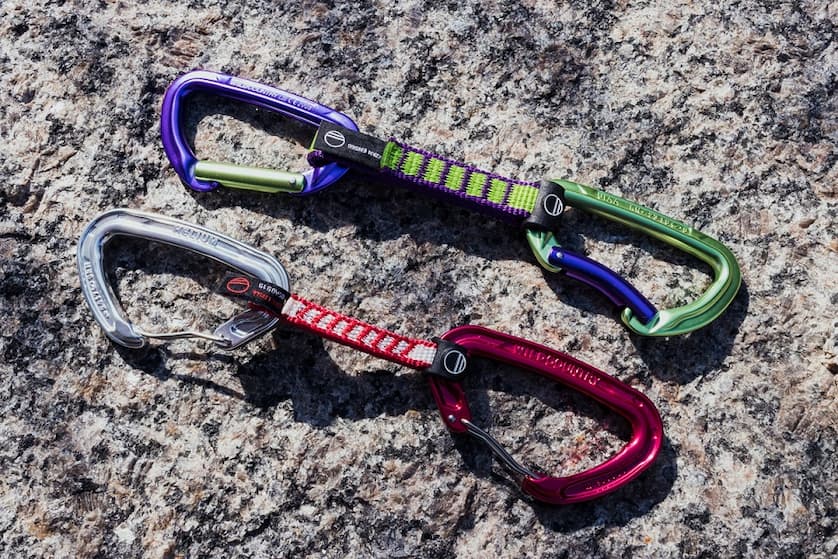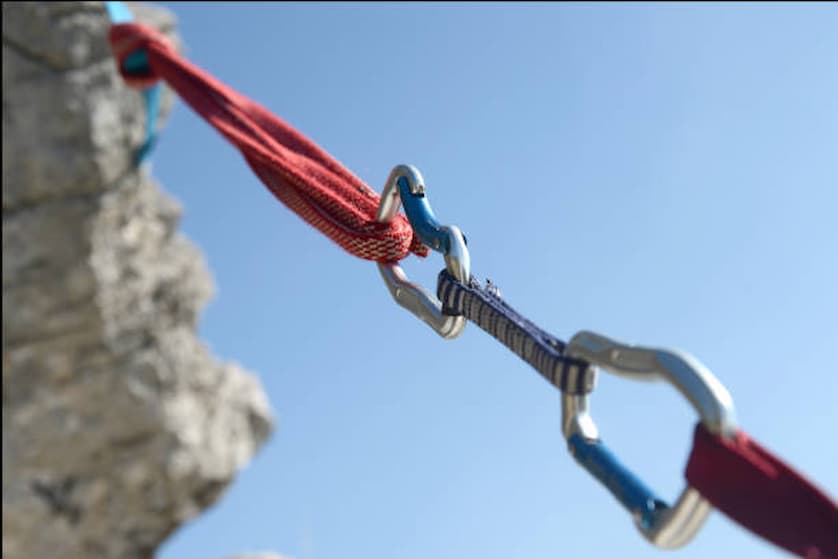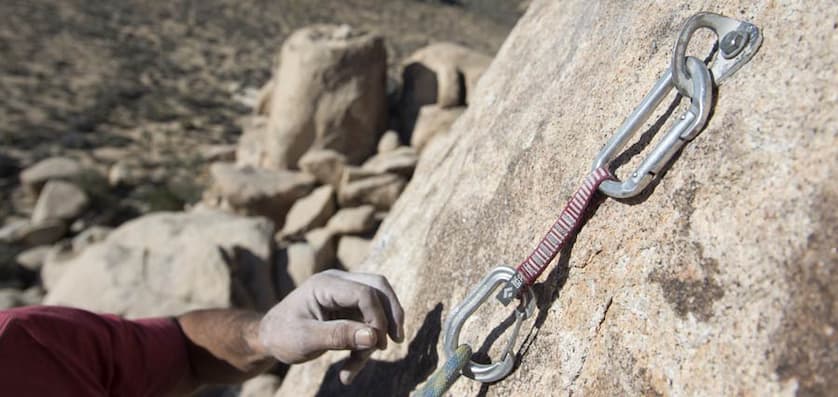Want to feel the exhilarating thrill of scaling a huge rock face? Feeling like you need to up the ante on your hikes and take on something a little more challenging? Well then rock climbing might be just the thing you’re looking for.
As much as we would all like to just head out into the wilderness and start climbing the first big rock we see, it’s just not that simple. After all, this is a dangerous sport and proper safety gear can oftentimes mean the difference between life and death. One such tool is a sturdy and reliable quickdraw to help you secure your rope as you make your ascent.
Contents
What Is a Quickdraw?

Climbing quickdraws are pieces of equipment used to fasten the climbing rope to the wall. They are made up of two carabineers joined by a so-called dogbone, or piece of semi-rigid stitched webbing. One carabineer is used to attach to the wall’s protection, which is typically a bolt, though it can also be clipped onto stoppers, cams, pitons, or other types of conventional protection.
The sewed dogbone is loosely connected to this carabiner so that it can move about. The other carabineer is held in a fixed position to the dogbone by a rubberised keeper.
To make clipping easier and to ensure that the carabineer is loaded in the best direction in the event of a fall, this carabineer, which is used to secure the climber’s rope while leading, must remain firmly in place.
Types of Quickdraws
There are three basic types of quickdraws. Price and weight are the two factors that differentiate the three varieties the most. Price increases and decreases based on weight, and vice versa (in general).
Lightweight Quickdraws
These draws have the tiniest carabineers and the thinnest slings, which are typically 10mm, making them the lightest in weight. They work best for traditional and alpine climbing but least well for everyday sport climbing. Although these draws are the least expensive ones, we advise you not to purchase them because of their affordable price especially if you’re new to this rock climbing thing.
Affordable Sport Draws
This group includes both ultra-lightweight draws and expensive, sport-specific draws. Despite being significantly more useable for sport climbing, these are typically heavier than the lightweight choices. They frequently cost more than the least-priced options, although they are still considerably less expensive than high-end sports ones.
For the vast majority of novice climbers looking for good value, this is the sweet spot. Moreover, any type of carabineer configuration is possible, including double solid gates, double wire gates, and hybrids with solid on top and wire on the bottom.
High-End Sport Draws
The high-end sports draws are yet the other extreme of the spectrum. Usually made of multiple solid gate carabineers, these are without a question the most effective models, and most top-level sport climbers will eventually acquire them. In fact, every novice should also get them if their budget allows it! They are by far the most expensive, but they are worthwhile in the end. However, you don’t want to carry a rack of them too far from the car because they are also the heaviest.
Quickdraw Features

A quickdraw is a relatively straightforward piece of rock climbing equipment and there aren’t many distinguishing characteristics that have a pronounced influence on use and performance.
Gates
A quickdraw’s carabineers will either have wire gates or solid gates. Wire gates have a looped piece of wire, whereas solid gates have a solid piece of aluminium to function as the gate. The manner they connect to the carabineer’s nose is the major factor.
The nose of the latest carabineer fits into a hole in the gate when solid gates are joined using a keylock mechanism. As a result, there is less possibility that the nose may get caught on something as you attempt to unclip it, such as the bolt hanger.
The hook and notch on the carabineer’s nose, on the other hand, are used to attach wire gates. When attempting to unclip bolts, this hook and notch may hang up more readily, especially on steep terrain. Any combination of wire and solid gate carabineers, as well as hybrids with wire on top and solid on the bottom, can be found on quickdraws.
Hot Forged vs. Cold Forged
Hot forged and cold forged are the two distinct ways in which aluminium carabineers can be produced. Hot forged carabineers are becoming more common, mostly because of their simpler design versatility as they can enable designers to construct I-beam forms, which effectively offer the same level of strength, with less material, as opposed to utilizing normal spherical metal stock.
These carabineers can also be constructed with more ridges for improved gripping and are typically made lighter while maintaining the same strength. It doesn’t matter if the carabiners on the quickdraws you are interested in are hot-forged or cold-forged, thus this shouldn’t be a factor in your decision.
Slings
While the sling on quickdraws is always a fixed length, you may typically pick between 12 cm and 18 cm lengths. The longer length is undoubtedly more versatile even though the shorter length may be more prevalent. Depending on the route, longer slings can be fastened from lower assuming the draws are already hanging. Nevertheless, longer slings tend to be a little more expensive and hang lower off your harness.
Another important consideration here is the width of the dogbone. For alpine climbing or big days, thinner slings are the best option because they are lighter and less bulky in the pack and on the harness. On the other hand, a wider sling is simpler to grip onto and grasp while making a clip.
This is a crucial factor to take into account for the majority of sport climbing, as extremely thin slings may be difficult to grasp and hold onto while clipping. However, a broader sling is preferable if you’re purchasing sports draws.
Important Considerations

Weight
If weight is important to you when completing your rock climbing or hiking gear, you may quickly rule out most of the field. Therefore, if you’re on the hunt for the lightest quickdraws, only those in the aforementioned lightweight category should be taken into consideration. However, bear in mind that most of these only work well for conventional or alpine climbing and are terrible draws for sport climbing.
However, if you are not concerned about having the lightest draws possible because you won’t be dragging this rack up tall cliffs or massive mountains, you should cross off the incredibly light draws and concentrate on the high-quality and expensive sports draws instead!
Experience Level
Generally speaking, experience level isn’t crucial when looking for the right quickdraws for your climbing pursuits. No matter how skilled you are or aren’t, don’t ever deceive yourself into thinking that having more costly quickdraws would improve your climbing.
It just comes down to personal preference. Some people have the nicest and premium quality quickdraws simply because they can afford them. Others want to conserve money since they are aware that quickdraws will eventually wear out and that they can send clipping from anywhere. So, at the end of the day, it’s all up to you.











